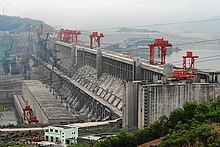ELECTRICITY GENERATION
Electricity generation
Electricity generation is the process of generating electric power from sources of primary energy. For electric utilities, it is the first process in the delivery of electricity to consumers. The other processes as transmission, distribution, energy storageand recovery using pumped-storage methods are normally carried out by the electric power industry. Electricity is most often generated at a power station by electromechanical generators, primarily driven by heat engines fuelled by combustion ornuclear fission but also by other means such as the kinetic energy of flowing water and wind. Other energy sources include solar photovoltaics and geothermal power.
The fundamental principles of electricity generation were discovered during the 1820s and early 1830s by the British scientist Michael Faraday. This method is still used today: electricity is generated by the movement of a loop of wire, or disc of copper between the poles of a magnet. Central power stations became economically practical with the development of alternating current power transmission, using power transformers to transmit power at high voltage and with low loss. Electricity has been generated at central stations since 1882. The first power plants were run on water power or coal,[1] and today rely mainly on coal, nuclear, natural gas, hydroelectric, wind generators, and petroleum, with supplementary amounts from solar energy, tidal power, and geothermal sources. The use of power-lines and power-poles have been significantly important in the distribution of electricity
Turbines[edit]
Almost all electrical power on Earth is generated with a turbine, driven by wind, water, steam or burning gas. The turbine drives a generator. There are many different methods of developing mechanical energy, including heat engines, hydro, wind and tidal power. Most electric generation is driven by heat engines. The combustion of fossil fuels supplies most of the heat to these engines, with a significant fraction from nuclear fission and some from renewable sources. The modern steam turbine(invented by Sir Charles Parsons in 1884) currently generates about 80% of the electric power in the world using a variety of heat sources. Power sources include:
- Steam
- Water is boiled by coal burned in a thermal power plant, about 41% of all electricity is generated this way.[4]
- Nuclear fission heat created in a nuclear reactor creates steam. Less than 15% of electricity is generated this way.
- Renewables. The steam is generated by Biomass, Solar thermal energy where solar parabolic troughs and solar power towersconcentrate sunlight to heat a heat transfer fluid, which is then used to produce steam, or Geothermal power.
- Natural gas: turbines are driven directly by gases produced by combustion. Combined cycle are driven by both steam and natural gas. They generate power by burning natural gas in a gas turbine and use residual heat to generate steam. At least 20% of the worlds electricity is generated by natural gas.
- Small turbines can be powered by Diesel engines. This is used for back up generation, usually at low voltages. Most large power grids also use diesel generators, originally provided as emergency back up for a specific facility such as a hospital, to feed power into the grid during certain circumstances.
- Water Energy is captured from the movement of water. From falling water, the rise and fall of tides or ocean thermal currents. Each driving a water turbine to produce approximately 16% of the world's electricity. The Perth Wave Energy Project is an early production, submerged buoy, electrical power and direct desalination installation supplying power to HMAS Stirling in Western Australia.
- The windmill was a very early wind turbine. In a solar updraft tower wind is artificially produced. Before 2010 less than 2% of the worlds electricity was produced from wind


Comments
Post a Comment